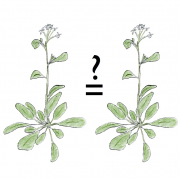CHM: Convergence of pathogens on common host proteins
We were able to contribute analyses based on 1001 Genomes data to his exciting project describing how a common set of host proteins is convergently targeted by effectors from pathogens representing three kingdoms of life, bacteria, fungi and oomycetes.
Cell Host Microbe. 2014 Sep 10;16(3):364-75. doi: 10.1016/j.chom.2014.08.004.
While conceptual principles governing plant immunity are becoming clear, its systems-level organization and the evolutionary dynamic of the host-pathogen interface are still obscure. We generated a systematic protein-protein interaction network of virulence effectors from the ascomycete pathogen Golovinomyces orontii and Arabidopsis thaliana host proteins. We combined this data set with corresponding data for the eubacterial pathogen Pseudomonas syringae and the oomycete pathogen Hyaloperonospora arabidopsidis. The resulting network identifies host proteins onto which intraspecies and interspecies pathogen effectors converge. Phenotyping of 124 Arabidopsis effector-interactor mutants revealed a correlation between intraspecies and interspecies convergence and several altered immune response phenotypes. Several effectors and the most heavily targeted host protein colocalized in subnuclear foci. Products of adaptively selected Arabidopsis genes are enriched for interactions with effector targets. Our data suggest the existence of a molecular host-pathogen interface that is conserved across Arabidopsis accessions, while evolutionary adaptation occurs in the immediate network neighborhood of effector targets.



